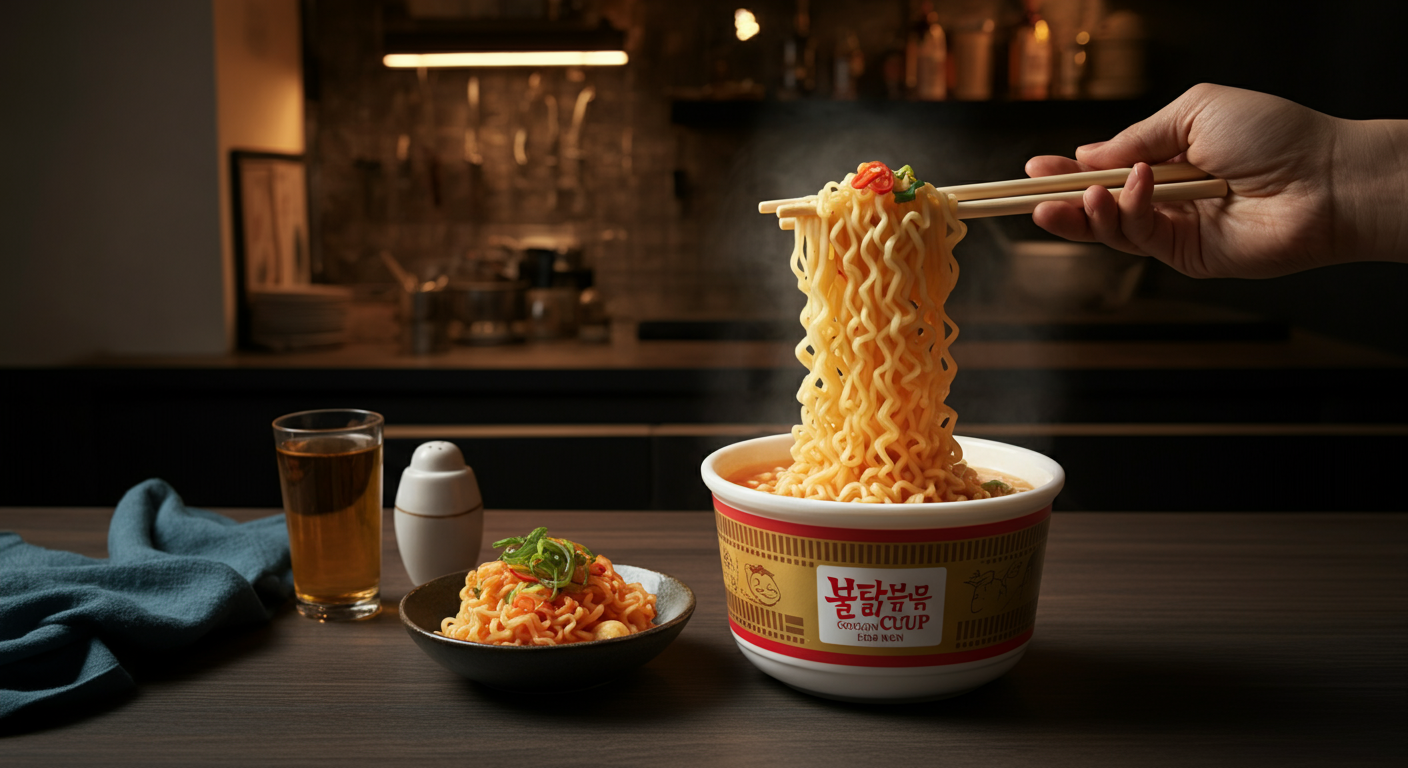Cup Noodle: The Korean Soul Healer

Cup Noodle (컵라면): Korea’s Ultimate Soul Food and Comfort Companion
Have you ever wondered what truly fuels a K-pop idol during a late-night practice, or what a K-drama character reaches for when they need a quick, comforting meal? Often, it’s not a gourmet dish, but something much simpler, much more profound: the humble **Cup Noodle (컵라면)**. In Korea, this isn’t just a snack; it’s a cultural icon, a reliable friend, and, believe it or not, a powerful balm for the soul. Trust me on this, once you understand its place in Korean hearts, you’ll see **Cup Noodle (컵라면)** in a completely new light.
Growing up in Korea, the scent of a freshly opened **Cup Noodle (컵라면)** was as common as the sound of cicadas in summer. It wasn’t just about satisfying hunger quickly; it was about the ritual, the warmth spreading through your hands, and the immediate comfort it brought. This seemingly simple convenience food has woven itself into the fabric of daily life, witnessing countless moments of joy, stress, and solace. From bustling city streets to quiet study rooms, the presence of **Cup Noodle (컵라면)** is undeniable. It perfectly encapsulates a blend of Korea’s fast-paced modernity and its deep-seated need for connection and relief, even in the smallest things. This isn’t just food; it’s an experience, a memory, and for many Koreans, a fundamental part of their personal story.
Cup Noodle (컵라면): More Than Just Instant Noodles, It’s a Lifestyle
In Korea, **Cup Noodle (컵라면)** transcends its humble packaging to become an indispensable part of daily life. It’s not just a quick meal; it’s an institution, a symbol of convenience, and a witness to countless moments. Walk into any convenience store (편의점: pyeon-uijeom), and you’ll be greeted by an entire aisle dedicated to an astonishing variety of these instant delights. This vast selection alone speaks volumes about its importance. Koreans consume an incredible amount of **Cup Noodle (컵라면)**, making it a staple in homes, offices, and on-the-go. Its omnipresence is truly remarkable.
This isn’t just about filling your stomach. It’s about a cultural phenomenon that touches every demographic. Students pull all-nighters fueled by its savory broth. Office workers grab a quick, satisfying lunch. Hikers enjoy a steaming hot cup at the mountain summit. **Cup Noodle (컵라면)** is a universal language of quick comfort. It’s the ultimate expression of the “bbali-bbali” (빨리빨리: quickly, quickly) culture, yet it also provides a moment of pause and enjoyment in a fast-paced world.
The Ultimate Convenience Store Companion (편의점의 친구)
The convenience store (편의점: pyeon-uijeom) and **Cup Noodle (컵라면)** are an inseparable pair, a true match made in heaven. Stepping into a Korean 편의점 is an experience in itself. You’ll find a dedicated hot water dispenser, disposable chopsticks, and often, small tables where people can enjoy their instant meals right then and there. This setup encourages a communal, yet personal, dining experience. It’s a common sight in K-dramas, too. Think of characters like the struggling but resilient leads in “Weightlifting Fairy Kim Bok-joo” or “Reply 1988,” sharing a late-night **Cup Noodle (컵라면)** after a long, tiring day. These scenes beautifully capture the sense of shared solace and connection.
One chilly evening, I remember seeing two friends, bundled in thick coats, laughing over their steaming **Cup Noodle (컵라면)** outside a 편의점. It wasn’t about the gourmet quality of the food. It was about the warmth, the company, and the simple joy of that shared moment. Often, a **Cup Noodle (컵라면)** is paired with a triangle kimbap (김밥: gimbap) or a boiled egg. This creates a surprisingly satisfying and balanced meal. It’s a perfect example of making the most of what’s available and finding unexpected satisfaction. You can even create your own mini-feast, truly.
From Study Fuel to Stress Reliever (야식의 대명사)
For many Koreans, **Cup Noodle (컵라면)** holds a special place as the quintessential late-night snack (야식: yasik). During my own student days, countless hours of studying were powered by these trusty cups. The spicy (맵다: maepda) broth was a jolt to keep me awake, and the satisfying noodles provided a much-needed energy boost. It’s not just students, though. Professionals working overtime, or even just friends hanging out late, often turn to **Cup Noodle (컵라면)** for that perfect end-of-day treat. It’s the ultimate stress reliever, a quick escape from the pressures of work or academics.
This shared experience of enjoying **Cup Noodle (컵라면)** fosters a unique sense of connection. We often talk about ‘정 (jeong),’ a deep feeling of affection, attachment, and loyalty that binds people together. Sharing a **Cup Noodle (컵라면)**, or even just being in the same space while eating it, can be a small expression of this ‘정 (jeong).’ It’s a silent acknowledgment of shared struggles and comforts. It’s saying, “We’re in this together.” The warmth of the noodles mirrors the warmth of human connection. It tastes even better when shared, or when it’s just you, finding peace in a cup.
The Healing Power of Cup Noodle (컵라면): A Bowl of Comfort for the Soul
Beyond its practical role as a quick meal, **Cup Noodle (컵라면)** often serves a much deeper purpose in Korea: it’s a source of genuine emotional healing. It’s not just about satisfying physical hunger; it’s about providing comfort, nostalgia, and a moment of peace when the world feels overwhelming. This might sound exaggerated for instant noodles, but in Korea, food carries profound cultural significance. Food is often a primary way to show care, express emotion, and find solace. **Cup Noodle (컵라면)**, in its unassuming way, fulfills these roles remarkably well.
Think about those moments in life when you just need something familiar, something that doesn’t demand effort but delivers satisfaction. That’s where **Cup Noodle (컵라면)** shines. It’s the ultimate comfort food for many, evoking a sense of calm and well-being. This is particularly true in a society that values hard work and often faces intense pressures. A simple, warm cup can provide a much-needed mental break.
The Unexpected Comfort in Every Slurp (영혼을 달래는 한 그릇)
There are days when you’re just exhausted, feeling a bit down, or simply overwhelmed. On those days, the thought of cooking a complex meal is unbearable. This is precisely when a **Cup Noodle (컵라면)** becomes a true lifesaver. Its simplicity is its strength. You just add hot water, wait a few minutes, and *poof* – a steaming, savory bowl of deliciousness (맛있어요: masisseoyo) is ready. The act of eating it, slurping the noodles, and feeling the warmth, offers an immediate, tangible sense of comfort. It’s like a warm hug in a cup.
I remember a time after a particularly difficult exam. I felt completely drained, both physically and emotionally. All I wanted was something easy, something familiar. I walked into a 편의점, bought a **Cup Noodle (컵라면)**, and sat outside, feeling the cool evening air. With each spoonful, a little bit of the stress seemed to melt away. It wasn’t a grand feast, but it was exactly what my soul needed. This simple act provided a small moment of healing (힐링: healing), a pause from the relentless pace of life. It offers a quiet, personal space for reflection and solace.
A Taste of Nostalgia and Shared Memories (추억이 담긴 맛)
**Cup Noodle (컵라면)** is deeply intertwined with memories and nostalgia for many Koreans. It reminds them of school trips, late-night talks with friends, or even tougher times like military service (군대: gundae), where a cup of ramen was considered a luxury. This historical association lends it a sentimental value that elevates it far beyond mere sustenance. When K-pop idols talk about their trainee days, they often mention **Cup Noodle (컵라면)** as a staple, a symbol of their hard work and dreams. It’s a testament to its enduring role in shaping personal journeys.
Consider the famous anecdote about soldiers in the military. After a grueling training exercise, a hot **Cup Noodle (컵라면)** isn’t just food; it’s a taste of freedom, a moment of relief, and a reminder of home. These shared experiences forge strong bonds and imbue the food with collective meaning. It represents overcoming hardship, finding joy in small things, and camaraderie. In a way, it’s a small, manageable antidote to ‘한 (han),’ that deep-seated feeling of unresolved sorrow or injustice, by providing a moment of simple, uncomplicated happiness. It’s a little bit of solace in a demanding world.
Elevating Your Cup Noodle (컵라면) Experience: Korean Style
While the basic **Cup Noodle (컵라면)** is perfectly satisfying on its own, Koreans have developed an incredible knack for customizing and elevating their instant noodle experience. This isn’t just about adding extra ingredients; it’s an art form, a way to personalize a mass-produced item and make it uniquely your own. This creative approach transforms a simple snack into a gourmet-level meal, showing ingenuity and a deep appreciation for flavor. It also reflects a cultural trait of making the best out of any situation.
This customization is a testament to the Korean love for food and the desire to make every meal special, no matter how simple. It’s about turning an ordinary moment into something extraordinary. Watching people carefully select their additions is almost as enjoyable as eating the finished product. This dedication to taste and enhancement is truly fascinating.
The Art of the ‘Upgrade’ (나만의 컵라면)
The most common way to upgrade your **Cup Noodle (컵라면)** is by adding various ingredients. A raw egg cracked directly into the hot noodles as they cook is a classic. The residual heat gently poaches the egg, adding richness and a silky texture to the broth. Another popular addition is a slice of cheese, which melts into a creamy, savory layer, toning down the spice and adding depth. Some people throw in tteok (떡: rice cakes) for a chewy texture, or even leftover grilled meat for a hearty boost. And, of course, a side of fresh, crunchy 김치 (kimchi) is practically mandatory, providing a refreshing counterpoint to the rich, spicy noodles.
You might be surprised to learn about the “ramyeon + rice” (밥 말아먹기: bab mara-meokgi) phenomenon. After finishing the noodles, many Koreans add a scoop of cooked rice to the leftover broth. The rice soaks up all the delicious, concentrated flavors, transforming it into a second, equally satisfying meal. This practice perfectly exemplifies the ‘소확행 (sohwaekhaeng)’ — “small, certain happiness” — finding immense joy in simple, everyday pleasures. It’s a truly ingenious way to extend the meal and enjoy every last drop.
Finding Joy in the Simple Pleasures (소확행의 순간)
The customization of **Cup Noodle (컵라면)** embodies the Korean philosophy of finding ‘소확행 (sohwaekhaeng)’. It’s about creating a moment of personal bliss, transforming something ordinary into a unique, satisfying experience. This isn’t about expensive ingredients or elaborate preparations. It’s about thoughtful additions and personal touches that make a simple meal feel special. The perfect **Cup Noodle (컵라면)**, tailored to your exact preferences, can spark a genuine feeling of happiness. This attention to detail reflects a broader cultural appreciation for savoring life’s small moments.
This practice also subtly connects to ‘눈치 (nunchi),’ the subtle art of social awareness and understanding a situation. Sometimes, the best, most appropriate, and most satisfying meal is a quick, customized **Cup Noodle (컵라면)**, especially when time is short or you need a quiet moment. It’s about knowing what you need and making it happen efficiently and delightfully. When you take that first bite of your perfectly customized **Cup Noodle (컵라면)**, you might just exclaim, “대박 (daebak)!” — meaning “awesome” or “jackpot” — a testament to how good it feels to hit that perfect spot. It’s a small victory in a busy day.
Conclusion
So, the next time you spot a **Cup Noodle (컵라면)**, whether in a Korean drama, a K-pop idol’s VLive, or on a store shelf, remember its profound significance. It’s far more than just quick sustenance. It’s a symbol of resilience, a source of comfort, and a canvas for culinary creativity. In Korea, **Cup Noodle (컵라면)** is truly a testament to finding joy and healing in the simplest of things. It has carved out an irreplaceable niche in the national psyche, serving as a reliable companion through thick and thin.
From being the ultimate convenience store (편의점: pyeon-uijeom) meal to the late-night study fuel (야식: yasik) for students and a wellspring of nostalgic memories, **Cup Noodle (컵라면)** carries immense cultural weight. It embodies ‘정 (jeong)’ through shared moments and offers a unique kind of healing (힐링: healing) when you need it most. It reminds us that even the most unassuming items can hold deep emotional value and become integral to a nation’s story. Go ahead, give it a try with this new perspective. Perhaps you’ll find your own moment of ‘소확행 (sohwaekhaeng)’ in a steaming cup. You might just discover that a bowl of **Cup Noodle (컵라면)** truly is soul food.


![Dear Mom, I Can’t Come to Dinner Because Baek Sa-eon Just [SPOILER] and I Need 3-5 Business Days to Recover](https://k-vibe.net/wp-content/uploads/2025/08/kvibe-thumbnail-20250829-215006-768x419.png)


